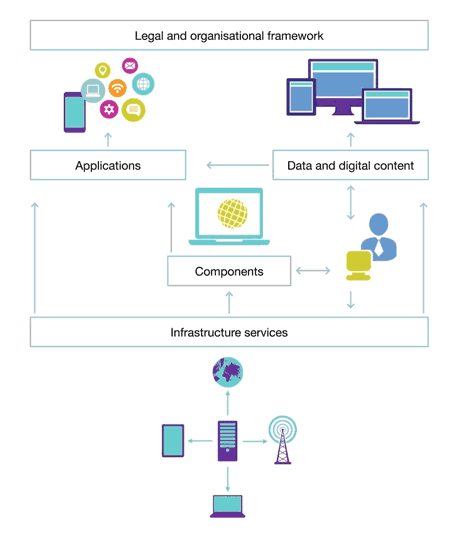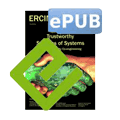by John Krogstie, Dirk Ahlers and Bjarne Helvik
Digital ecosystems encompass both ICT services and digital infrastructures, and their interactions with their surroundings. Prime challenges in such systems are the lack of coordinated engineering and management which, if not properly handled, can threaten the trustworthiness of the overall system. A holistic view of services and infrastructures is required, focusing on the relationships and dependencies between communication networks, data storage, service provisioning, and management of services and infrastructure.
New ICT-solutions are not created from scratch, but are based on building upon a large number of existing and evolving systems and services – ‘systems of systems’. Since the sub-systems are not under any centralized control and exhibit emergent features, the term ‘digital ecosystems’ was proposed to describe such systems. Digital ecosystem is a metaphor inspired by natural ecosystems to describe a distributed, adaptive, and open socio-technical system. A wide range of individuals and organizations use and provide data, content and services to the digital ecosystem, as shown in Figure 1. Such systems are ideally characterized by self-organization, autono-mous subsystems, continuous evolution, scalability and sustainability, aiming to provide both economic and social value. On the other hand, as these systems grow organically, it also opens them up for a number of threats to the overall dependability and thus trustworthiness of the system.

Figure 1: Types of actors and interactions in digital ecosystems.
There are three partly related variants of digital ecosystems: software ecosystems, data-oriented ecosystems, and infrastructure ecosystems.
Software ecosystems are “a set of businesses functioning as a unit and interacting with a shared market for software and services, together with relationships among them. These relationships are frequently underpinned by a common technological platform and operate through the exchange of information, resources, and artifacts” [2]. For instance, within open source systems (OSS), hundreds of thousands of co-evolved software ‘components’ are freely available. Their quality and documentation is rather variable. Yet, OSS components are integrated into many applications, and some also contribute back [1]. Traditional customers – such as municipalities – cooperate to provide improved e-services for their inhabitants. And end-users, even children, are becoming developers of components for the potential use of others.
Data-oriented ecosystems: In recent years, an increasing amount of data and meta-data has been made available for common use, representing the basis for an ecosystem of services being developed based on the shared online data. Of particular interest is the explosion of linked open data that makes it possible to access, interpret, and share heterogeneous and dynamically changing data across the Web with limited knowledge of how the data was produced. Since applications don’t need to have any ownership to this data or to have access to an appropriate infrastructure for local management of large-scale data, the provision of linked open data enables a new breed of data-driven applications which are more cost-effective to develop and can combine data in new and innovative ways. Moreover, anyone can contribute to the total data model by publishing their own definitions, making sure that the data model is dynamically adapted and is relevant for outside use. It is in the nature of such data to be both heterogeneous and distributed. This creates new challenges, as this data often cannot be transferred owing to volume or legal constraints.
A variant of data-oriented ecosystems are content ecosystems - networks that deal with creation and sharing of artistic or intellectual artifacts. The Web allows for highly visual and multimodal interactions, and these interactions will become represented through richer means.
The third eco-system, and critical with respect to trustworthiness, is the ICT infrastructure ecosystem. It consists of a huge number of interconnected networks, computing and storage facilities, owned and operated by a number of autonomous market actors [3]. In addition, it has infrastructure services, such as positioning, and infrastructure information, such as maps, that a range of end user services rely on. The organization of these systems is mostly based on bilateral commercial agreements between market actors, and hence, it is a techno-economic eco-system rather than an engineered system. There may be regulations that put requirements on these systems and their interworking, but these are of a general kind.
In summary, there is no entity that has a global view of how this system of systems is organized and has an ability to deal with events ‘across systems’ that may threaten the ecosystem’s role as the critical infrastructure our modern societies to an increasing degree rely on. It is a research challenge to understand the behaviour of this eco-system and to develop technology that ensures robustness to random failures, attacks, mistakes, natural disasters, etc. as well as combinations of these threats.
To address the trustworthy application of combined digital content, software and infrastructure ecosystems, there must be substantial and concerted improvements of the state-of-the-art in five traditionally unrelated and partially isolated research areas:
1. Open innovation
2. Software engineering
3. Enterprise architecture and enterprise modelling
4. (Big) Data management
5. Quantitative modelling of ICT infrastructure.
In complex digital ecosystems, such as those underlying Smart Cities or Smart Grids, aspects from all of these areas interplay, and to understand how to design, implement, manage, and operate trustworthy systems on top of the digital ecosystem, we need to be able to look at the different aspects in concert. How can we exploit the innovative opportunities arising by the digital ecosystems, whilst maintaining the overall trustworthiness and resilience of the total system? OADE – Open, Autonomous Digital Ecosystems, is a research program at NTNU, coordinating resources from computer science, information systems, telecommunications, and power engineering to address this versatile problem. We are looking at these issues from an interdisciplinary perspective to develop cross-cutting reliable solutions suited to flexible and autonomous digital ecosystems.
Link:
http://www.ntnu.edu/ime/oade
References:
[1] Ø. Hauge, C. Ayala, R. Conradi: “Adoption of Open Source Software in Software-Intensive Industry - A Systematic Literature Review”, Information and Software Technology, 52(11):1133-1154, 2010.
[2] S. Jansen, A. Finkelstein, S. Brinkkemper: “A sense of community: A research agenda for software ecosystems”, ICSE 2009, New and Emerging Research Track - Companion Volume, 2009.
[3] A. F. v. Veenstra et al.: “Infrastructures for public service delivery: Complexities of governance and architecture in service infrastructure development, e-services Journal, 2012.
Please contact:
John Krogstie, NTNU, Norway
Tel: +47 93417551
E-mail:











